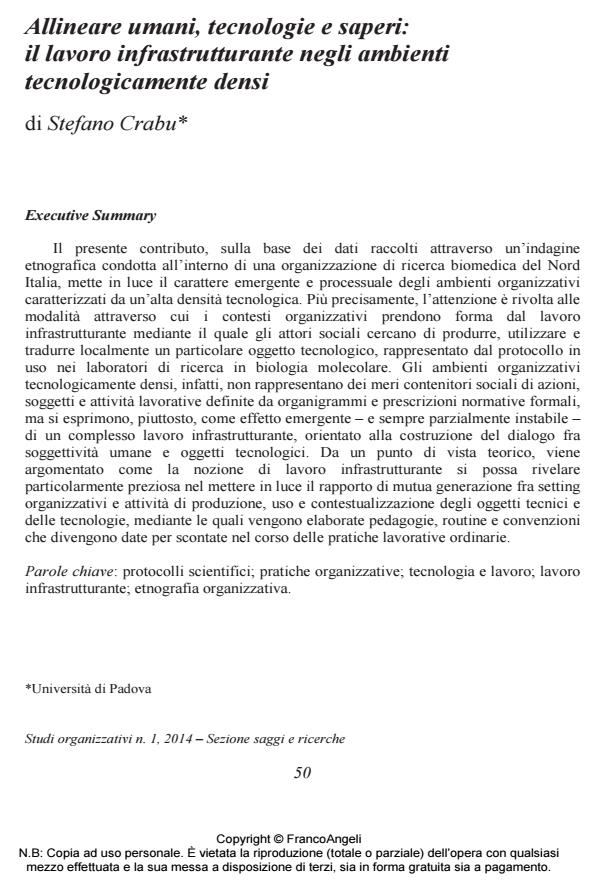Allineare umani, tecnologie e saperi: il lavoro infrastrutturante negli ambienti tecnologicamente densi
Titolo Rivista STUDI ORGANIZZATIVI
Autori/Curatori Stefano Crabu
Anno di pubblicazione 2014 Fascicolo 2014/1
Lingua Italiano Numero pagine 23 P. 50-72 Dimensione file 248 KB
DOI 10.3280/SO2014-001003
Il DOI è il codice a barre della proprietà intellettuale: per saperne di più
clicca qui
Qui sotto puoi vedere in anteprima la prima pagina di questo articolo.
Se questo articolo ti interessa, lo puoi acquistare (e scaricare in formato pdf) seguendo le facili indicazioni per acquistare il download credit. Acquista Download Credits per scaricare questo Articolo in formato PDF

FrancoAngeli è membro della Publishers International Linking Association, Inc (PILA)associazione indipendente e non profit per facilitare (attraverso i servizi tecnologici implementati da CrossRef.org) l’accesso degli studiosi ai contenuti digitali nelle pubblicazioni professionali e scientifiche
Il presente contributo, sulla base dei dati raccolti attraverso un’indagine etnografica condotta all’interno di una organizzazione di ricerca biomedica del Nord Italia, mette in luce il carattere emergente e processuale degli ambienti organizzativi caratterizzati da un’alta densità tecnologica. Più precisamente, l’attenzione è rivolta alle modalità attraverso cui i contesti organizzativi prendono forma dal lavoro infrastrutturante mediante il quale gli attori sociali cercano di produrre, utilizzare e tradurre localmente un particolare oggetto tecnologico, rappresentato dal protocollo in uso nei laboratori di ricerca in biologia molecolare. Gli ambienti organizzativi tecnologicamente densi, infatti, non rappresentano dei meri contenitori sociali di azioni, soggetti e attività lavorative definite da organigrammi e prescrizioni normative formali, ma si esprimono, piuttosto, come effetto emergente - e sempre parzialmente instabile - di un complesso lavoro infrastrutturante, orientato alla costruzione del dialogo fra soggettività umane e oggetti tecnologici. Da un punto di vista teorico, viene argomentato come la nozione di lavoro infrastrutturante si possa rivelare particolarmente preziosa nel mettere in luce il rapporto di mutua generazione fra setting organizzativi e attività di produzione, uso e contestualizzazione degli oggetti tecnici e delle tecnologie, mediante le quali vengono elaborate pedagogie, routine e convenzioni che divengono date per scontate nel corso delle pratiche lavorative ordinarie.
Parole chiave:Protocolli scientifici; pratiche organizzative; tecnologia e lavoro; lavoro infrastrutturante; etnografia organizzativa.
- Assessing the technological maturity of small enterprises through a collaborative approach Andrea Tomo, in STUDI ORGANIZZATIVI 2/2019 pp.147
DOI: 10.3280/SO2018-002007 - Real and apparent changes of organizational processes in the era of big data analytics Marcello Martinez, Primiano Di Nauta, Debora Sarno, in STUDI ORGANIZZATIVI 2/2018 pp.91
DOI: 10.3280/SO2017-002005
Stefano Crabu, Allineare umani, tecnologie e saperi: il lavoro infrastrutturante negli ambienti tecnologicamente densi in "STUDI ORGANIZZATIVI " 1/2014, pp 50-72, DOI: 10.3280/SO2014-001003